The 1937 Ford Model 78, a symbol of American automotive ingenuity, marked a significant milestone in the history of Ford Motor Company. Introduced during the Great Depression, the Model 78 represented a shift towards streamlined design and technological advancements, captivating the hearts of American drivers.
This era witnessed a resurgence in the automobile industry, with Ford leading the charge in innovation and affordability.
The Model 78 was a testament to Ford’s commitment to engineering excellence, incorporating features like hydraulic brakes and a powerful V8 engine, setting a new standard for performance and safety. It became a popular choice for families and individuals seeking reliable transportation, contributing to the burgeoning American middle class.
Introduction to the 1937 Ford Model 78
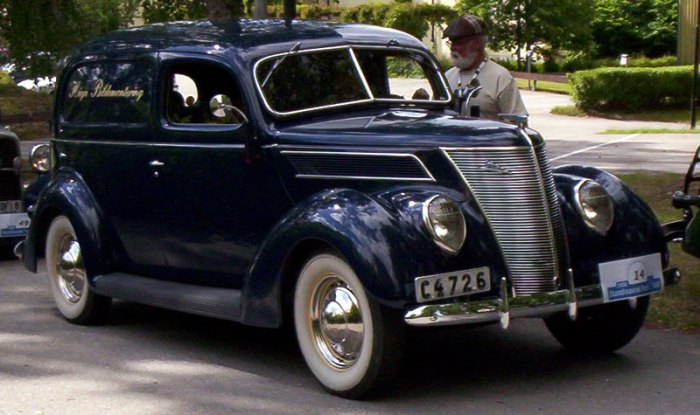
The 1937 Ford Model 78, affectionately known as the “Ford Deluxe,” marked a significant milestone in automotive history. It was a pivotal model that ushered in a new era of design and engineering for Ford, solidifying the company’s position as a leader in the American automobile market.
This model was introduced during a period of economic recovery and social change, reflecting the optimism and aspirations of the time. The Model 78’s arrival coincided with the end of the Great Depression and the beginning of a period of economic expansion.
The American public was eager to embrace new technologies and enjoy the fruits of a recovering economy. The Model 78, with its sleek design and advanced features, perfectly captured this spirit of optimism and modernization.
Key Design Features of the 1937 Ford Model 78
The Model 78 was a departure from previous Ford models, showcasing a more streamlined and modern aesthetic. It featured a lower, more aerodynamic body, rounded fenders, and a distinctive “waterfall” grille that became a signature design element for Ford.
This new design not only enhanced the car’s appearance but also improved its performance and fuel efficiency.
Engine and Transmission
The Model 78 was powered by a 221 cubic inch, 85 horsepower V8 engine. This engine, a significant upgrade from previous Ford models, offered a combination of power and efficiency that appealed to drivers. The engine was paired with a three-speed manual transmission, providing a smooth and reliable driving experience.
Interior and Features
The interior of the Model 78 was designed with comfort and style in mind. It featured a spacious cabin with plush upholstery, a new instrument panel, and improved sound insulation. The Model 78 also offered a range of optional features, including a radio, heater, and rearview mirror, catering to the growing demand for creature comforts in automobiles.
Safety Features
Safety was also a priority in the design of the Model 78. The car featured a new, more rigid frame, improved brakes, and a larger windshield for better visibility. These features contributed to a safer driving experience for occupants.
Significance of the 1937 Ford Model 78
The 1937 Ford Model 78 was a significant model for Ford for several reasons:
- It helped Ford solidify its position as a leader in the American automobile market. The Model 78’s sleek design, advanced features, and affordability made it a popular choice for American consumers.
- It marked a significant shift in Ford’s design philosophy, embracing a more modern and streamlined aesthetic.
- It set the stage for future Ford models, influencing the design and engineering of subsequent vehicles.
The 1937 Ford Model 78 was a car that captured the spirit of its time, reflecting the optimism and progress of the era. It remains a significant model in automotive history, showcasing Ford’s commitment to innovation and its ability to produce cars that resonated with the American public.
Design and Engineering
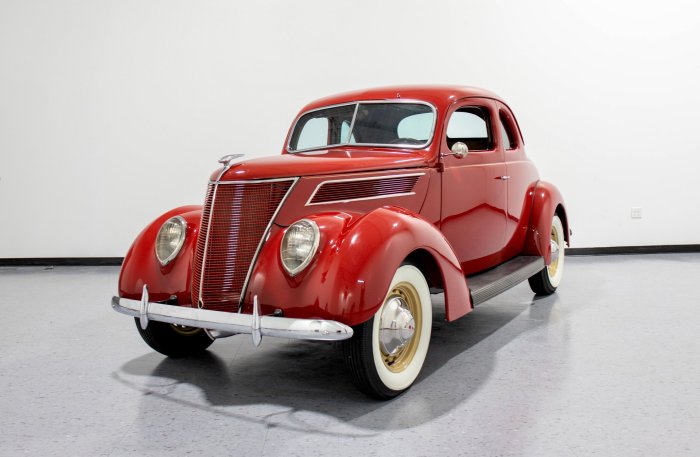
The 1937 Ford Model 78 was a significant advancement in automotive engineering, showcasing a blend of durability, innovation, and affordability. Its design and engineering elements reflected the era’s technological strides, particularly in areas like engine performance and braking systems.
Chassis and Suspension
The Model 78’s chassis was built with a sturdy, all-steel construction, providing a solid foundation for its robust performance. It featured a conventional ladder frame, with a front suspension system employing a transverse leaf spring. This design, while simple, provided a comfortable ride and good handling characteristics.
The rear suspension incorporated a semi-elliptic leaf spring, which effectively absorbed road irregularities. This combination of front and rear suspension systems ensured a balanced ride, making the Model 78 suitable for both city driving and longer journeys.
Engine and Transmission
The Model 78 was powered by a 221 cubic inch, straight-eight engine, known for its smooth and quiet operation. This engine, producing approximately 85 horsepower, was a testament to Ford’s commitment to providing reliable and efficient power. The engine was mated to a three-speed manual transmission, which offered a smooth and responsive gear change experience.
Hydraulic Brakes
One of the most notable features of the Model 78 was the incorporation of hydraulic brakes. This innovative technology, a departure from the traditional mechanical brake systems, provided superior braking performance and control. The hydraulic system ensured a more consistent and responsive braking action, contributing to enhanced safety and driver confidence.
Comparison with Contemporary Automobiles
Compared to other automobiles of its time, the Model 78 stood out for its combination of affordability, practicality, and performance. While some competitors offered more luxurious features or advanced technology, the Model 78’s focus on durability and efficiency made it a popular choice for families and individuals seeking reliable transportation.
Its robust engine, combined with its comfortable ride and innovative hydraulic brakes, made it a compelling option in the competitive automotive market of the 1930s.
Production and Marketing: 1937 Ford Model 78
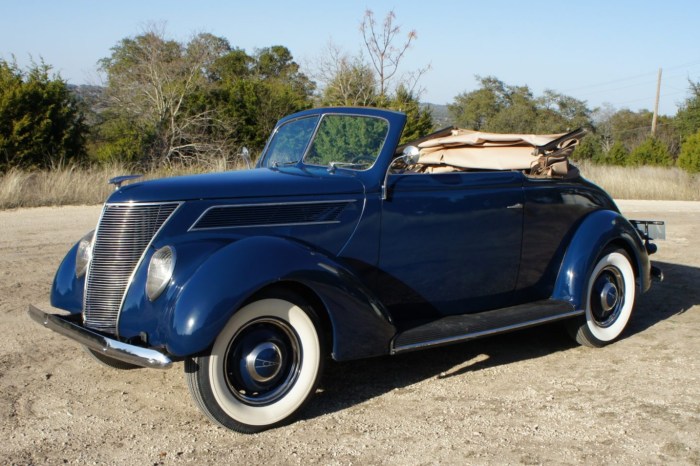
The 1937 Ford Model 78 was a testament to Ford’s commitment to efficient manufacturing and innovative marketing strategies. The car’s success was built on a foundation of streamlined production and a targeted marketing approach that resonated with consumers.The Model 78’s production was a marvel of modern engineering.
The 1937 Ford Model 78, a classic American automobile, represents a pivotal moment in automotive history. Its sleek design and powerful engine made it a popular choice for drivers across the country. While the Model 78 is a testament to the elegance of the era, it’s interesting to compare it to a later model like the 1956 Ford Street Rod , which embodies the spirit of customization and performance.
Both vehicles, though separated by nearly two decades, showcase the evolution of Ford’s design philosophy and the enduring appeal of classic American cars.
Ford’s assembly line, constantly refined and optimized, played a crucial role in the car’s affordability and accessibility.
Assembly Line Production
The assembly line was the heart of Ford’s production process, allowing for the efficient and rapid production of vehicles. The Model 78 benefited from this system, which was further enhanced by the introduction of new technologies and techniques.
- Specialized Workstations:Each worker was assigned a specific task, allowing for a division of labor and increased efficiency.
- Conveyor Belts:Conveyor belts transported the chassis and components along the assembly line, ensuring a smooth and continuous flow of production.
- Standardized Parts:Ford’s commitment to interchangeable parts allowed for mass production and reduced manufacturing costs.
Marketing Strategies
Ford employed a multifaceted marketing approach to promote the Model 78, targeting a broad audience with compelling messages and a focus on the car’s affordability and practicality.
The 1937 Ford Model 78, a classic American car, represented a significant shift in automotive design. Its sleek lines and advanced features set a new standard for the era. While the Model 78 was a symbol of elegance and sophistication, Ford’s legacy continued to evolve with the introduction of the robust 1978 Ford F250 , a workhorse known for its durability and power.
Both vehicles, separated by decades, showcase Ford’s ability to adapt and innovate, catering to diverse needs and marking their place in automotive history.
- Advertising Campaigns:Ford’s advertising campaigns emphasized the Model 78’s affordability, durability, and modern features, attracting a wide range of consumers.
- Dealership Network:Ford’s extensive network of dealerships provided convenient access to the Model 78 for potential buyers across the country.
- Publicity and Events:Ford actively participated in public events and exhibitions to showcase the Model 78, generating positive publicity and increasing consumer awareness.
Impact on Sales and Profitability
The Model 78’s success was reflected in Ford’s sales and profitability. The car’s affordability and appeal to a wide range of consumers contributed to strong sales figures.
“The Model 78 was a major success for Ford, selling over 500,000 units in its first year of production. It helped to solidify Ford’s position as a leading automaker in the United States.”
The 1937 Ford Model 78, a classic example of American automotive design, represents a pivotal moment in Ford’s history. While this model embodied the elegance and practicality of its era, the evolution of the Ford truck continued, leading to the iconic 1978 Ford F150.
This later model, with its rugged design and powerful engine, solidified Ford’s reputation for building dependable and capable vehicles. The 1937 Ford Model 78, however, remains a cherished symbol of a bygone era, showcasing the timeless appeal of classic American automobiles.
Cultural Impact
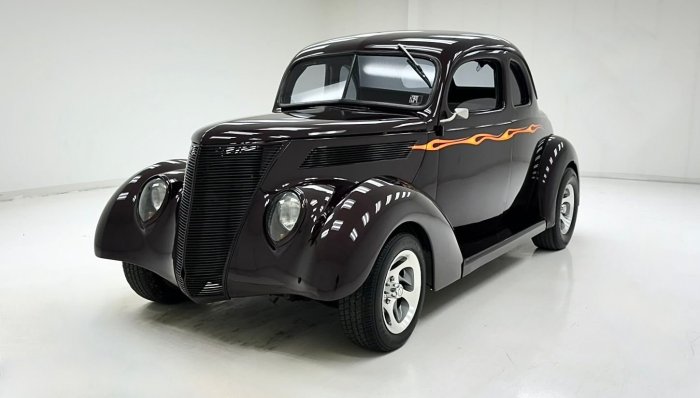
The 1937 Ford Model 78, a symbol of American industrial might and design ingenuity, left an indelible mark on popular culture and automotive history. Its sleek lines, innovative features, and widespread popularity cemented its place as an icon of the era, influencing everything from cinematic depictions to automotive trends.
The Model 78 in Film and Television, 1937 Ford Model 78
The Model 78’s presence in film and television further solidified its cultural impact. Its timeless design and association with the era made it a popular choice for filmmakers seeking to evoke a sense of nostalgia and authenticity.
- The Model 78 made its debut on the silver screen in the 1937 film “The Life of Emile Zola,” a biographical drama that chronicled the life of the renowned French writer. The car’s appearance in the film showcased its sleek and modern design, aligning it with the film’s themes of progress and innovation.
- In the 1940s, the Model 78 appeared in numerous films, often as a symbol of wealth and status. For example, in the classic film noir “The Maltese Falcon” (1941), a Model 78 is driven by the character of Sam Spade, a private investigator who embodies the era’s spirit of grit and determination.
- The Model 78’s popularity continued into the 1950s and 1960s, with appearances in films such as “The Asphalt Jungle” (1950) and “The Day the Earth Stood Still” (1951). These films further solidified the Model 78’s image as a symbol of American ingenuity and design.
- Beyond film, the Model 78 also made appearances in television shows, such as “The Adventures of Superman” (1952-1958), where it was driven by the character of Lois Lane, showcasing its versatility and appeal to a wide audience.
Influence on Automotive Design and Trends
The Model 78’s design, with its streamlined body, integrated headlights, and flowing curves, set a new standard for automotive aesthetics. It significantly influenced the design language of automobiles for years to come.
- The Model 78’s sleek and aerodynamic design, inspired by the emerging principles of streamlining, became a dominant trend in the automotive industry. This trend was further amplified by the growing popularity of the Model 78, with other manufacturers adopting similar design elements in their vehicles.
- The Model 78’s innovative features, such as the integrated headlights and the use of chrome accents, became popular design cues that were widely adopted by other car manufacturers. This influence is evident in the design of numerous automobiles produced in the following decades.
- The Model 78’s success in the market also demonstrated the growing demand for stylish and affordable automobiles. This trend contributed to the development of more accessible and stylish cars, leading to a significant shift in the automotive landscape.
The Model 78 as a Symbol of American Ingenuity and Innovation
The Model 78’s widespread popularity and enduring legacy as a design icon solidify its status as a symbol of American ingenuity and innovation. Its success in the market during a time of economic hardship highlighted the strength and resilience of American manufacturing.
- The Model 78’s affordability and practicality made it accessible to a wide range of consumers, demonstrating Ford’s commitment to producing vehicles that met the needs of the American public. This accessibility played a significant role in the Model 78’s success, contributing to its enduring legacy as a symbol of American ingenuity and innovation.
- The Model 78’s design innovations, such as the integrated headlights and the use of chrome accents, showcased Ford’s commitment to technological advancements and design excellence. These innovations set a new standard for automotive design, influencing the industry for decades to come.
- The Model 78’s enduring popularity as a design icon further solidifies its status as a symbol of American ingenuity and innovation. Its timeless design and association with the era continue to captivate audiences, cementing its place in automotive history.
Technical Specifications
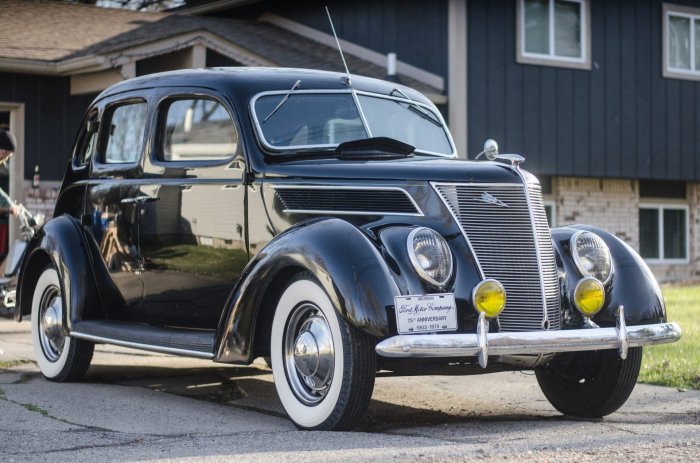
The 1937 Ford Model 78, like its predecessors, was a testament to Ford’s commitment to engineering innovation and affordability. Its technical specifications played a crucial role in its success, offering a balance of power, efficiency, and practicality that resonated with a wide range of buyers.
Technical Specifications of the 1937 Ford Model 78
The 1937 Ford Model 78 was powered by a 221 cubic inch (3.6 L) V8 engine, a significant departure from the previous year’s six-cylinder models. This engine was known for its smooth performance and fuel efficiency, making it a popular choice for both personal and commercial use.
| Specification | Value |
|---|---|
| Engine Size | 221 cubic inches (3.6 L) |
| Horsepower | 85 hp |
| Transmission Type | 3-speed manual |
| Wheelbase | 112 inches (2,845 mm) |
| Length | 174 inches (4,420 mm) |
| Width | 68 inches (1,727 mm) |
| Height | 62 inches (1,575 mm) |
| Weight | 2,850 lbs (1,293 kg) |
Historical Significance
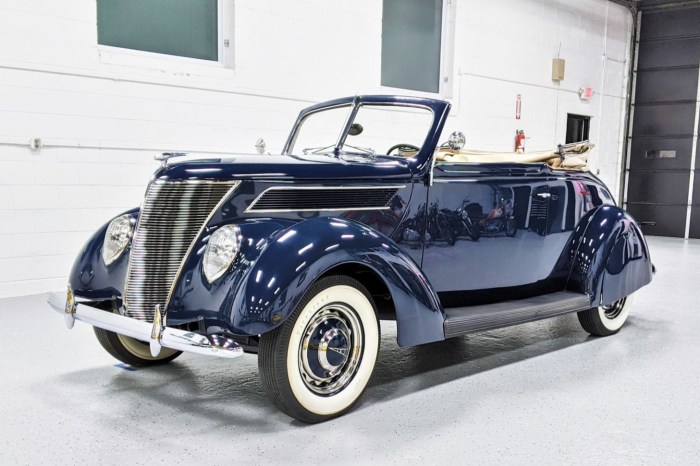
The 1937 Ford Model 78 stands as a significant milestone in the American automotive industry, marking a turning point in design, engineering, and manufacturing. Its impact extended beyond the realm of automobiles, influencing the American economy and society in profound ways.
Impact on the American Automobile Industry
The Model 78’s introduction coincided with a period of rapid innovation and growth in the American automobile industry. The car’s streamlined design, featuring a rounded body and integrated headlights, set a new standard for aesthetics and aerodynamics. This design philosophy, pioneered by Ford, became a defining characteristic of American cars throughout the 1930s and 1940s.The Model 78 also incorporated several advancements in engineering, including a new, more powerful V8 engine and an improved suspension system.
These innovations contributed to the car’s performance and handling, enhancing the driving experience and solidifying Ford’s reputation as a leader in automotive technology.
Impact on the American Economy and Society
The Model 78’s success played a pivotal role in the economic recovery following the Great Depression. Ford’s mass production techniques, coupled with the car’s affordability, made it accessible to a wider segment of the population. This increased demand for automobiles stimulated economic growth, creating jobs and boosting consumer spending.The Model 78’s widespread adoption also had a significant impact on American society.
The car’s affordability and practicality facilitated a shift towards suburban living, as people could now commute to work and enjoy leisure activities beyond their immediate neighborhoods. This shift in lifestyle further fueled economic growth and contributed to the rise of the American middle class.
Historical Events and Figures
The Model 78’s production coincided with several key historical events. The car was introduced just a few years after the end of the Great Depression, providing a much-needed boost to the American economy. It was also launched during the era of the New Deal, a series of programs designed to stimulate economic recovery and provide relief to those affected by the Depression.
The Model 78 was also associated with the rise of Henry Ford’s son, Edsel Ford, who played a prominent role in the design and marketing of the car. Edsel Ford’s vision for a more stylish and luxurious Ford was evident in the Model 78’s design, marking a departure from the utilitarian aesthetics of earlier Ford models.
Modern Relevance
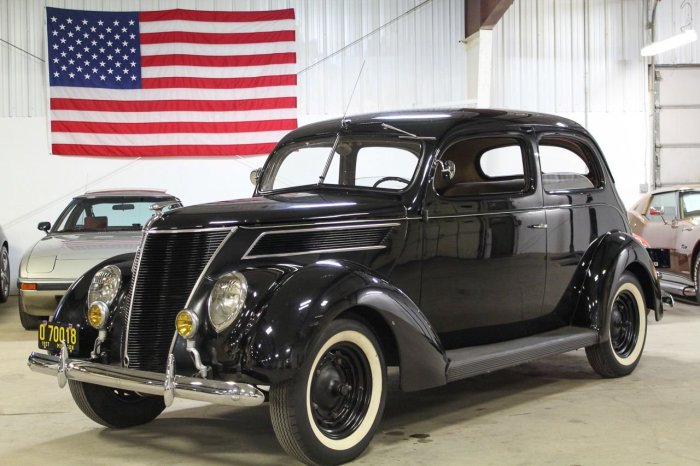
While the 1937 Ford Model 78 is no longer in production, its legacy continues to resonate with automotive enthusiasts, collectors, and even contemporary car designers. Its timeless design and innovative features have earned it a permanent place in automotive history, inspiring and influencing generations of carmakers.
Importance for Automotive Enthusiasts and Collectors
The Model 78 remains a highly sought-after collectible for automotive enthusiasts and collectors worldwide. Its elegant design, powerful engine, and historical significance make it a prized possession for those who appreciate the golden age of automobiles. The Model 78’s value has steadily increased over the years, making it a valuable investment for collectors.
- Rarity:The Model 78’s limited production run, combined with its popularity, has made it a rare and desirable collectible. Finding a well-preserved example in excellent condition is a true treasure for any collector.
- Historical Significance:The Model 78 represents a pivotal moment in automotive history, marking the transition from the Art Deco era to a more streamlined and modern aesthetic. Its influence on subsequent Ford models and the automotive industry as a whole is undeniable.
- Restorations and Preservation:Many Model 78s have been lovingly restored to their former glory by dedicated enthusiasts, ensuring their continued existence and appreciation. These restorations often involve meticulous attention to detail, using original parts and techniques to preserve the car’s authenticity.
Influence on Contemporary Automotive Design
The Model 78’s design principles, particularly its emphasis on streamlining and aerodynamic efficiency, continue to influence contemporary automotive design. Its sleek lines and integrated features have inspired carmakers to create vehicles that are both stylish and functional.
- Aerodynamics:The Model 78’s streamlined bodywork, featuring a sloping hood, rounded fenders, and integrated headlights, was a testament to the growing importance of aerodynamics in automotive design. This focus on reducing drag and improving fuel efficiency has become a cornerstone of modern car design.
- Simplicity and Elegance:The Model 78’s clean lines and minimalist design aesthetic have inspired contemporary carmakers to create vehicles that are both elegant and functional. The emphasis on simplicity and clean lines has become a hallmark of modern design, especially in luxury and performance cars.
- Iconic Features:The Model 78’s iconic features, such as its distinctive grille and teardrop-shaped headlights, have been reinterpreted and incorporated into modern car designs. These elements serve as a reminder of the Model 78’s enduring legacy and influence on automotive design.
Ultimate Conclusion
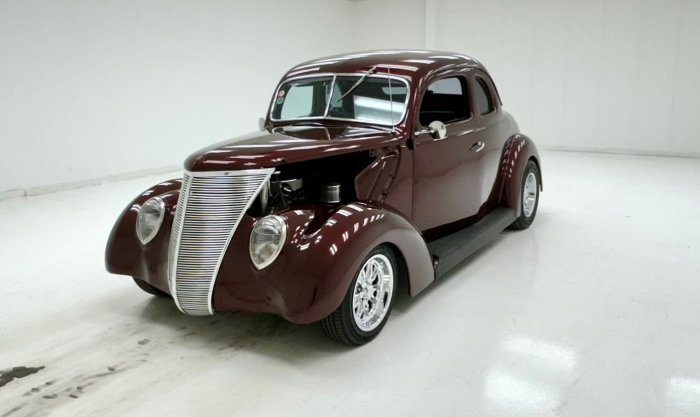
The 1937 Ford Model 78 left an indelible mark on American culture, becoming an iconic symbol of the era. Its streamlined design, innovative features, and affordability made it a beloved car, influencing automotive trends for decades to come. Today, the Model 78 continues to be cherished by collectors and enthusiasts, reminding us of the enduring legacy of American automotive engineering and the cultural significance of the automobile in American society.